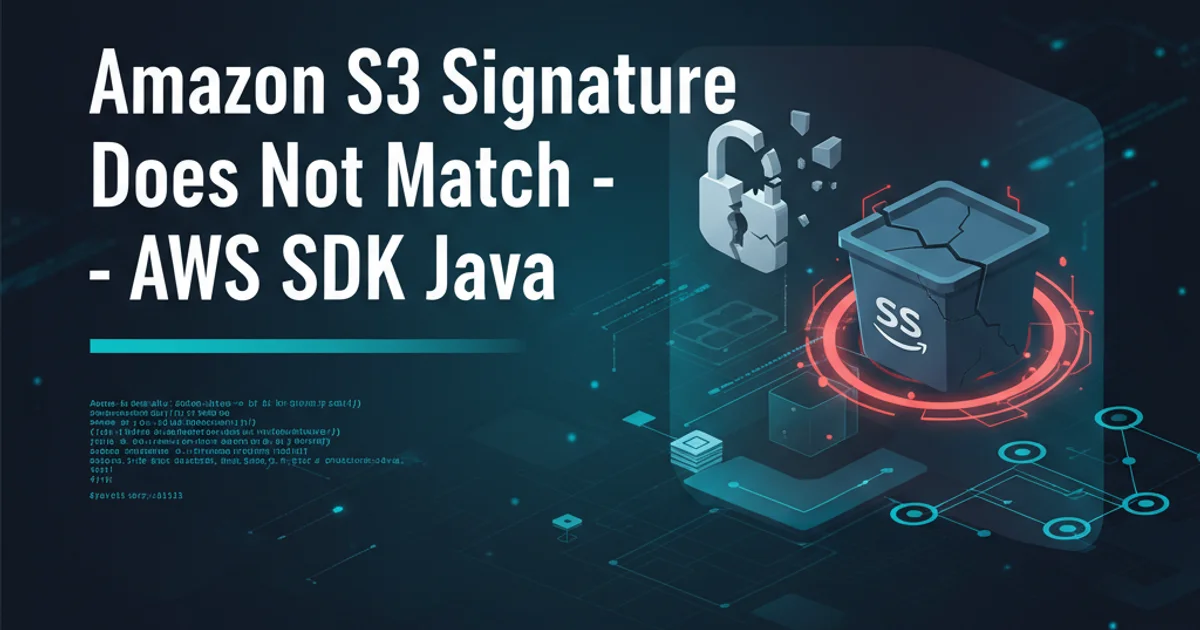Amazon S3 Signature Does Not Match - AWS SDK Java
Categories:
Resolving 'Signature Does Not Match' Errors with AWS S3 and Java SDK

Understand and troubleshoot the common 'SignatureDoesNotMatch' error when interacting with Amazon S3 using the AWS SDK for Java, covering common causes and solutions.
The SignatureDoesNotMatch error is one of the most common and frustrating issues developers encounter when working with Amazon S3. This error indicates that the signature calculated by your application using your AWS credentials does not match the signature calculated by AWS S3. Essentially, S3 cannot verify the authenticity of your request. This article will delve into the primary causes of this error when using the AWS SDK for Java and provide practical solutions to resolve it.
Understanding the AWS Signature Process
Before diving into troubleshooting, it's crucial to understand how AWS signs requests. Every request made to AWS services, including S3, must be cryptographically signed. This signature proves that the request was made by someone with valid AWS credentials and that the request hasn't been tampered with. The signing process involves several steps, including canonicalizing the request, creating a string to sign, and then signing that string with your secret access key. Any discrepancy in these steps, however minor, will lead to a SignatureDoesNotMatch error.
sequenceDiagram
participant Client
participant AWSSDK
participant S3
Client->>AWSSDK: Initiate S3 Request (e.g., PutObject)
AWSSDK->>AWSSDK: Canonicalize Request (Headers, URL, Body)
AWSSDK->>AWSSDK: Create String-to-Sign
AWSSDK->>AWSSDK: Sign String-to-Sign with Secret Key
AWSSDK->>S3: Send Signed Request (includes Signature)
S3->>S3: Re-calculate Signature using Request & Client's Access Key
alt Signature Matches
S3-->>AWSSDK: Success Response
AWSSDK-->>Client: Success
else Signature Does Not Match
S3-->>AWSSDK: Error: "SignatureDoesNotMatch"
AWSSDK-->>Client: Throw S3Exception
endAWS S3 Request Signing Process Overview
Common Causes and Solutions
The SignatureDoesNotMatch error is almost always related to incorrect credentials, region, or request parameters. Here are the most frequent culprits and how to address them:
1. Incorrect AWS Credentials
This is by far the most common reason. Even a single incorrect character in your Access Key ID or Secret Access Key will cause the signature to fail. Ensure there are no leading/trailing spaces or typos.
import software.amazon.awssdk.auth.credentials.AwsBasicCredentials;
import software.amazon.awssdk.auth.credentials.StaticCredentialsProvider;
import software.amazon.awssdk.regions.Region;
import software.amazon.awssdk.services.s3.S3Client;
public class S3ClientBuilder {
public static S3Client buildClient(String accessKey, String secretKey, String regionName) {
return S3Client.builder()
.region(Region.of(regionName))
.credentialsProvider(StaticCredentialsProvider.create(
AwsBasicCredentials.create(accessKey, secretKey)))
.build();
}
public static void main(String[] args) {
// !!! REPLACE WITH YOUR ACTUAL CREDENTIALS AND REGION !!!
String awsAccessKeyId = "YOUR_ACCESS_KEY_ID";
String awsSecretAccessKey = "YOUR_SECRET_ACCESS_KEY";
String awsRegion = "us-east-1"; // e.g., us-east-1, eu-west-1
try {
S3Client s3Client = buildClient(awsAccessKeyId, awsSecretAccessKey, awsRegion);
// Attempt an S3 operation, e.g., listing buckets
s3Client.listBuckets().buckets().forEach(bucket -> System.out.println(bucket.name()));
System.out.println("Successfully listed S3 buckets.");
} catch (Exception e) {
System.err.println("Error interacting with S3: " + e.getMessage());
if (e.getMessage().contains("SignatureDoesNotMatch")) {
System.err.println("HINT: Check your AWS Access Key ID, Secret Access Key, and Region.");
}
}
}
}
Example of building an S3Client with explicit credentials. Double-check these values.
2. Incorrect AWS Region
The region specified in your S3 client configuration must match the region where your S3 bucket resides. If you try to access a bucket in eu-west-1 with a client configured for us-east-1, you'll likely get a signature mismatch or a bucket not found error.
Verify the region of your S3 bucket in the AWS Management Console and ensure your S3Client is initialized with the exact same region.
3. System Clock Skew
AWS uses timestamps in its signature calculation to prevent replay attacks. If your system's clock is significantly out of sync with AWS's servers (typically more than 5-15 minutes), the signature will be invalid. This is less common with modern operating systems that automatically sync time, but it can happen in isolated environments.
To resolve this, ensure your system's clock is synchronized with a reliable NTP (Network Time Protocol) server. For Linux, you can use ntpdate or chrony. For Windows, ensure automatic time synchronization is enabled.
4. Special Characters in Object Keys or Metadata
While S3 supports a wide range of characters in object keys, certain special characters (especially non-ASCII or those requiring URL encoding) can sometimes cause issues if not handled correctly by the SDK or if there's a mismatch in encoding. The AWS SDK for Java generally handles this well, but it's worth considering if other solutions fail.
If you suspect this, try uploading an object with a simple alphanumeric key and minimal metadata to see if the error persists. If it resolves, investigate how your application is generating and encoding object keys or metadata.
5. Proxy or Network Intermediaries
If your application communicates with S3 through a proxy server or other network intermediary, it's possible that the intermediary is modifying the request headers or body. Even minor modifications can invalidate the signature.
Check your proxy configuration. If possible, try bypassing the proxy temporarily to see if the error disappears. Ensure that the proxy is not adding or removing headers that are part of the signature calculation.
6. IAM Permissions and Policies
While less likely to directly cause a SignatureDoesNotMatch error (which is an authentication failure), incorrect IAM permissions can sometimes manifest in confusing ways. If your IAM user or role lacks the necessary permissions for the S3 action you're attempting, you might get an AccessDenied error, but in some edge cases, it could contribute to signature issues if the request itself is malformed due to permission-related constraints.
Review your IAM policies to ensure the principal making the request has s3:GetObject, s3:PutObject, s3:ListBucket, or whatever specific S3 actions are required for your operation.
software.amazon.awssdk package can offer valuable insights into the exact request being sent and the signature calculation process, helping to pinpoint discrepancies.